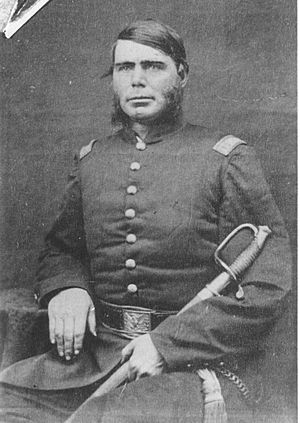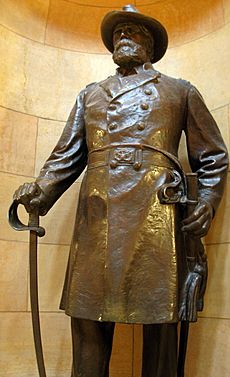William J. Colvill facts for kids
Quick facts for kids
William J. Colvill Jr.
|
|
|---|---|

Captain William Colvill in 1861 or 1862
|
|
| 3rd Minnesota Attorney General | |
| In office 1866–1868 |
|
| Governor | William R. Marshall |
| Preceded by | Gordon E. Cole |
| Succeeded by | Francis R. E. Cornell |
William J. Colvill Jr. (born April 5, 1830 – died June 12, 1905) was an important American soldier and politician. He was a colonel in the Union Army during the American Civil War. He led the brave 1st Minnesota Volunteer Infantry regiment, especially during the famous Battle of Gettysburg. After the war, he served as Minnesota Attorney General from 1866 to 1868. He was also a member of the Minnesota House of Representatives.
Contents
Early Life and Career
William Colvill Jr. was born in Forestville, New York, on April 5, 1830. His parents were from Ireland and Scotland. He went to Fredonia Academy. After that, he taught at a country school for one year.
Colvill then studied law in Forestville and Buffalo. He learned law in the office of Millard Fillmore, who later became a U.S. President. In 1851, he became a lawyer. He worked as a lawyer in Forestville for about three years.
In 1854, Colvill moved to Minnesota. He spent his first year in St. Paul. There, he worked as a clerk and then as a secretary for the Territorial Council. Later, he moved to Cannon Falls. He bought land there, where part of the city now stands.
He opened a law office in Red Wing in 1854. In 1855, he started a newspaper called The Red Wing Sentinel. His newspapers always supported the Democratic Party. However, they always stood for the Union and against states leaving the country. People who held these views before the war were called Union Democrats. They generally supported the ideas of Stephen A. Douglas.
Serving in the Civil War
When the Civil War began, William Colvill was 31 years old. He was the first person from Goodhue County, Minnesota, to volunteer for the army. The local men chose him as captain of Company F. This company was part of the 1st Minnesota Volunteer Infantry Regiment. On June 26, 1861, his regiment arrived in Washington D.C..
First Battle of Bull Run
About a month later, Colvill's regiment marched south into Virginia with the Union Army. On July 21, they fought the Confederate Army near Manassas, Virginia. This was the First Battle of Bull Run. The 1st Minnesota fought hard on Henry House Hill. They were told to help Rickett's Battery.
The 1st Minnesota was one of the last regiments to leave the battlefield. They had the most soldiers killed, wounded, or missing of any Northern regiment. They lost 48 killed, 83 wounded, and 30 missing.
The Seven Days Battles
The Union Army, now led by General George B. McClellan, moved to a peninsula in Virginia. They marched towards Richmond. The two armies fought many battles over a week. These were called the Seven Days Battles. On June 30, 1862, at the Battle of White Oak Swamp, Colvill was shot in the shoulder. He was sent to Baltimore to recover for the rest of the summer.
Battle of Antietam
Colvill returned to his unit on August 31. Soon after, he was promoted to major. On September 17, his unit, with 435 men, fought in the Battle of Antietam. The 1st Minnesota was on the far right side of their brigade. They were part of John Sedgwick's division. This division made a difficult attack on the West Woods.
The unit suffered many losses: 15 killed, 79 wounded, and 21 missing. After the battle, Colvill was promoted again, to lieutenant colonel.
Fredericksburg, Chancellorsville, and Haymarket
On December 11, the 1st Minnesota helped capture the town of Fredericksburg. The unit saw little action during the Battle of Chancellorsville. After that battle, General Joseph Hooker marched the Army of the Potomac north. They were going to stop General Robert E. Lee's invasion of Pennsylvania.
On June 23, Colvill was promoted to colonel and became the commander of his regiment. Two days later, on June 25, J. E. B. Stuart's cavalry attacked the unit. This was the Battle of Haymarket. During the fight, Colvill was leading his regiment when his horse was shot from under him.
The march from Fredericksburg to Gettysburg took 14 days. They traveled for 11 of those days, averaging over 14 miles a day. By the time they reached the small town, the soldiers were very tired.
The Battle of Gettysburg
On July 2, 1863, Colvill's regiment was held back on Cemetery Ridge at Gettysburg. In the morning, Colvill was put back in command of his regiment. Late in the afternoon, Confederate General Cadmus Wilcox's Alabama Brigade broke through the Union lines.
Colvill quickly ordered his men to charge against a much larger Confederate force. There were 262 Minnesotans who made the charge. A total of 215 of them were killed or wounded. Even with these heavy losses, the Minnesotans successfully slowed the Confederates. This gave time for more Union regiments to arrive. During the fight, a private soldier captured the flag of the 14th Virginia Infantry.
Colvill was among the wounded. He was hit three times and severely hurt. One bullet entered his right shoulder and went across his back. It clipped part of his spine and stopped under his left shoulder blade. He was also shot in the ankle. These wounds meant Colvill had to use a cane for the rest of his life.
After the battle, Colvill recovered in a private home in Gettysburg. Surgeons wanted to remove his foot to save his life, but Colvill refused. He was then sent to a hospital in Harrisburg, Pennsylvania. He stayed there until February 1864. That month, he rejoined his regiment as they were leaving the army and going home.
Back in Red Wing, Minnesota, he worked as an editor for the Red Wing Republican newspaper. During this time, he was elected to the Minnesota State Legislature. He took his seat in January 1865. After the legislature finished its work, he was appointed as colonel of the 1st Minnesota Heavy Artillery Regiment. This regiment was stationed in Chattanooga. On May 6, 1865, he was given the honorary rank of brigadier general. He left the army in July 1865.
Later Life and Public Service
After the war, Colvill returned to the state legislature until 1866. He was then elected Minnesota Attorney General. He served in this important legal role from 1866 to 1868. After that, he went back to his law practice in Red Wing.
He also served again in the Minnesota House of Representatives in 1878. For the next ten years, he worked as the register of the Duluth Land Office, from 1887 to 1891.
Personal Life and Legacy
Colvill married Elizabeth Morgan in April 1867. She was a direct descendant of Elder Brewster, one of the Pilgrim Fathers. In 1893, Colvill had a 167-acre homestead in Grand Marais, Minnesota. It was next to Lake Superior. Other people settled there, creating a small community. After his death, this community was named Colvill in 1906.
In 1905, Colvill traveled to the Soldiers Home in Minneapolis. He went there for a reunion of veterans from the First Minnesota regiment. While there, he died in his sleep on June 13. He is buried in the Cannon Falls Community Cemetery in Cannon Falls, Minnesota. His original statue stands on a hill overlooking the cemetery. In 1928, President Calvin Coolidge was present for the dedication of another statue placed near his grave.
Colvill Park in Red Wing, Minnesota, is named after William Colvill. Another statue of him is located in the Minnesota State Capitol. Also, a part of Minnesota State Highway 19 is named in his honor. This section runs from Gaylord to Red Wing.
See also
- List of American Civil War brevet generals (Union)


